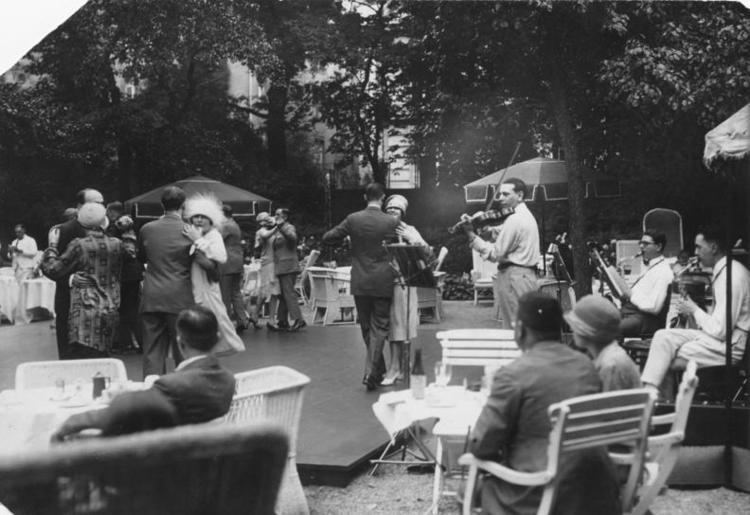 | ||
A tea dance, also called a thé dansant (French for "dancing tea"), is a summer or autumn afternoon or early-evening dance from four to seven p.m., sometimes preceded in the English countryside by a garden party. The function evolved from the concept of the afternoon tea, and J. Pettigrew traces its origin to the French colonization of Morocco. Books on Victorian Era etiquette such as Party-giving on Every Scale (London, n.d. [1880]), included detailed instructions for hosting such gatherings. By 1880 it was noted "Afternoon dances are seldom given in London, but are a popular form of entertainment in the suburbs, in garrison-towns, watering-places, etc." Tea dances were given by Royal Navy officers aboard ships at various naval stations, the expenses shared by the captain and officers, as they were shared by colonels and officers at barrack dances in mess rooms ashore.
Contents
The usual refreshments in 1880 were tea and coffee, ices, champagne-cup and claret-cup, fruit, sandwiches, cake and biscuits. Even after the introduction of the phonograph, the expected feature was a live orchestra – often referred to as a palm court orchestra – or a small band playing light classical music. The types of dances performed during tea dances included waltzes, tangos and, by the late 1920s, the Charleston.
The expenses of a seated supper, wine and candles associated with a ball were obviated by the tea dance. A stiff waxed canvas dancing cloth strained over the drawing-room carpet was considered sufficient, rather than taking up the carpet and waxing the floor in preparation for dancing. The dining room served as the tea-room, with the dining-tables arranged at one end as a buffet. For the older generation, a tea dance was a reception akin to an "at home". Floral decorations were modest.
Gay tea dances
The term, sometimes spelled T-dance or T dance, is also used within gay culture to designate similar dances: particularly those held on weekends (especially Sunday evenings) in nightclubs, or at the end of the day at gay resorts. Gay tea dances are also a prevalent featured event at circuit party festivals, where they are usually held outdoors and typically precede the indoor Sunday night 'closing party' of the festival. Gay tea dances have also become a major featured entertainment component on-board many gay-oriented cruises.
World records
Four World Record Tea Dances have been held in the early 21st century. In Glasgow in December 2008, some 408 dancers gained the record during the city's Winterfest celebrations. The programme of music for the event was provided by the Scottish swing dance band That Swing Sensation, with dance hosts the Fly Right Dance Company. The previous record was set in 2005 by a total of 195 couples, who danced in London's Trafalgar Square.
Subsequently, the Royal Opera House in London held a World Record attempt on 8 July 2010 in Trafalgar Square, with the unofficial total being 507 dancers.
Hot on the heels of the London event, Glasgow's George Square was the venue for the current official record, set on 12 September 2010, with 4,000 dancers.
In popular culture
Tea dances are a common cultural reference in early 20th-century British and American fiction as a staple of genteel society, where people normally attend these receptions while visiting resort towns, especially coastal ones such as Brighton, the Hamptons, Provincetown, or Ogunquit. The 1925 hit Broadway musical, No, No, Nanette, features a tea dance as the occasion for the plot's climax: the main characters travel to Atlantic City (the same musical also features the famous song "Tea for Two," which is sung prior to this scene).
In the United States, since the late 20th century, the term has been broadened to refer to any casual afternoon dance event. In 1981 the Hyatt Regency walkway collapse in Kansas City, Missouri occurred during an afternoon dance; resulting casualties were 114 people killed and 200 injured.
